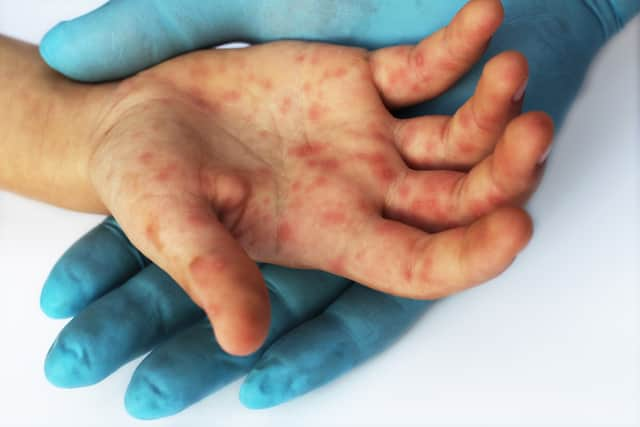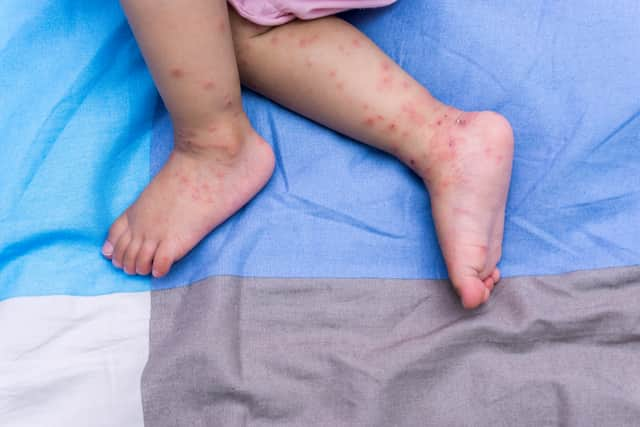Hand foot and mouth disease: is it contagious in adults and children - early symptoms including rash explained
and live on Freeview channel 276
As we enter the summer months, it’s approaching the time of year when hand, foot and mouth disease becomes most common and contagious.
This is everything you need to know - including how it’s treated, and when it’s time to see a doctor.
What is hand, foot and mouth disease?
Advertisement
Hide AdAdvertisement
Hide AdHand, foot and mouth disease is a common childhood illness that can also affect adults.
It generally causes blisters on the hands and feet, and ulcers in the mouth.
Hand, foot and mouth disease should not be conflated with foot and mouth disease, which only affects cattle, sheep and pigs - not humans.
The disease is most common during the late summer and early autumn, and it is extremely contagious. The virus is usually spread via droplets of mucus or saliva in the air from things like coughing or sneezing.
Advertisement
Hide AdAdvertisement
Hide AdIt can also spread by direct contact with the fluid from the blisters of someone that has the disease.
What are the symptoms?
Bupa explains that the initial symptoms of hand, foot and mouth disease can present in the following ways:
- A fever
- A sore throat
- A cough
- Loss of appetite
- Pain in your stomach


If it is hand, foot and mouth disease, you may start to develop other symptoms within a few days, including:
- Blisters or ulcers in your mouth
- Spots or blisters on your hands and feet
- A rash
The NHS says that symptoms are usually the same in adults and children, but they can be worse in babies and children under five.
How is it treated?
Advertisement
Hide AdAdvertisement
Hide AdUsually hand, foot and mouth disease gets better on its own in around seven to 10 days - there are no medicines or antibiotics that you can take to cure the virus.
To ease your symptoms, you should:
- Drink lots of fluids to prevent dehydration, but avoid acidic drinks like fruit juices
- Eat soft foods like yoghurt, and avoid hot and spicy foods
- Take over the counter painkillers like paracetamol or ibuprofen to help ease pain in your mouth or throat
A pharmacist may be able to recommend treatments like mouth ulcer gels and mouthwashes to help relieve the pain. They will also be able to show you which ones are suitable for children.
When should I see a doctor?
While hand, foot and mouth disease generally gets better on its own after seven to 10 days, there are a few scenarios in which you should see your GP.
The NHS says you should see your doctor if:
- The symptoms have not improved after seven to 10 days
- You or your child has a very high temperature, or feels hot and shivery
- You’re worried about your child’s symptoms
- Your child is dehydrated - they’re not peeing as often as usual
- You’re pregnant and have hand, foot and mouth disease
How to stop the virus from spreading?
Because the virus is easily transmitted from person to person, it’s important to take measures to stop the disease from being passed on.


Advertisement
Hide AdAdvertisement
Hide AdYou can start spreading it from a few days before you even have any symptoms, and you’re most likely to spread it to others in the first five days after your symptoms start.
To reduce spreading hand, foot and mouth disease, the NHS says:
- Wash your hands often with soap and water - and children’s hands too
- Use tissues to trap germs when you cough or sneeze
- Bin used tissues as quickly as possible
- Do not share towels or household items like cups or cutlery
- Wash soiled bedding and clothing on a hot wash
Comment Guidelines
National World encourages reader discussion on our stories. User feedback, insights and back-and-forth exchanges add a rich layer of context to reporting. Please review our Community Guidelines before commenting.
